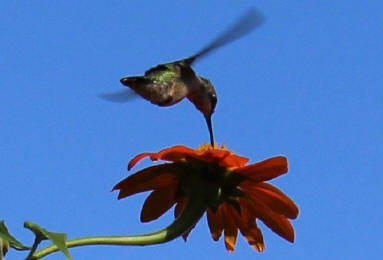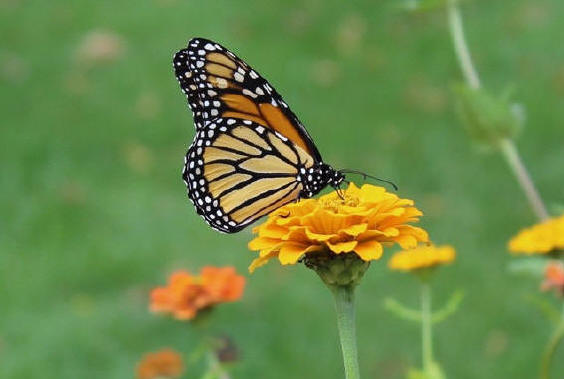Songbirds, hummingbirds and butterflies are the darlings of the backyard garden. They add excitement and beauty and bring life and movement to stationary plants. It’s hard to find anyone who doesn’t love to see a bluebird, cardinal or large, colorful butterfly. Did you know their numbers are diminishing from loss of habitat?
Every living creature needs four things to survive and reproduce: food. water, shelter, and food for their young. This is what we call a habitat. If you want to see birds and butterflies, create a habitat.
Many people put up bird and hummingbird feeders, and many birds appreciate them; but if you want them to become permanent guests, create a habitat of plants that they love, water to drink, shelter and insects to feed their young. A diverse combination of annuals, perennials and native shrubs is the key. Common perennials that birds love include Anise Hyssop, Tickseed,
Yarrow, Lavender, Cone Flowers, Black-eyed Susan, Sunflowers, Joe Pye Weed, Goldenrod and Sedums. Different birds prefer one over the other, so a wide variety of flowers is important. The plants just mentioned are the ones you don’t want to cut off as they finish blooming. Leave the seed heads standing so birds can enjoy them through the winter.
 Our ruby throated hummingbirds migrate south in the winter but follow the blooms north in early spring. By early to mid-April they usually begin to arrive in our area. Native Columbine and spring flowering trees are plants that will attract the
early arrivals and invite them to take up residence in your yard. They will stay as long as your yard offers a steady supply of blooms through the summer and into fall.
Our ruby throated hummingbirds migrate south in the winter but follow the blooms north in early spring. By early to mid-April they usually begin to arrive in our area. Native Columbine and spring flowering trees are plants that will attract the
early arrivals and invite them to take up residence in your yard. They will stay as long as your yard offers a steady supply of blooms through the summer and into fall.
Plants are only one part of the equation, however. The largest part of a typical songbird’s and hummingbird's diet is insects, and about 97% raise their young exclusively on insects such as spiders, mosquitoes, flies, crickets, beetles, and especially caterpillars. Insects are the protein source baby birds need for quick growth.
Bluebirds not only raise their young on insects, but the adult bluebird eats a diet of mainly insects. They will perch on a high spot and search the ground for a yummy insect then swoop down to collect it. This is why bluebirds prefer to nest near open areas.
If you regularly apply insecticides to your garden and lawn, don't expect to see many birds. Besides the sad fact that insecticides can make a bird very sick, you are cutting off their food supply. With nothing to eat or feed their young, the birds will nest elsewhere.
Native plants are important because they tend to attract more beneficial insects which, in turn, will attract more birds that will keep the insect population in check.
Most native shrubs produce fruit of some sort which support the birds. Birds favor native plants over non-native plants when choosing their meals.
Birds use trees, shrubs and ornamental grasses for shelter and protection from predators. Some birds eat sap from trees, but mostly they search the cracks in tree bark for insects.
Water is probably the most important thing you can offer songbirds. They not only drink; they need to keep their feathers clean. They especially are attracted to moving water. A birdbath with a "water wriggler" will be a big hit. Water in winter is even more important. Use a heater to keep the birdbath water from freezing.
Hummingbirds like to hover while they eat. They have a very long beak with an especially long tongue that is built for reaching inside deep, tubular flowers. They especially love Canna Lilies, Honeysuckle, any of the Salvias, Trumpet Vines, and Fuchsia. Like the songbirds, hummingbirds feed their babies insects exclusively. Hummingbirds actually incorporate spider silk
into their tiny nests. The silk allows the nest to expand as the babies grow.
Hummingbirds like to drink sugar water from feeders especially if there is not enough flower diversity to meet their needs. To make the sugar water, mix one cup of sugar with four cups of boiling water and let it cool before filling the feeder. Never add dye to the water. Store any extra sugar water in the refrigerator and change the feeder water regularly to prevent
it from spoiling.
Many of the same plants that attract songbirds also attract butterflies. Butterflies start life as caterpillars. If you kill off the caterpillars, there will be no butterflies. Just planting flowers will get you butterflies that are passing through, but if you want them to take up residence, you need to supply some host plants which provide food for the babies in the
form of caterpillars. There are different host plants for different species of butterflies. Most butterfly host plants are actually trees such as Oak, Red Maple, Sassafras, and Willows. Other important host plants include Milkweed (Asclepsia), Carrot family plants (Parsley, Dill, Fennel), violets and clover, to name a few.

Butterflies prefer flowers with a wide, sturdy landing zone. Coneflower, Rudbeckia (Black-eyed Susan), Zinnia, and Tithonia (Mexican Sunflower) are some favorites. They also love Liatris, Garden Phlox, and Sedums.
As more and more natural habitat is destroyed with the building of highways, cities, housing developments and parking lots, our backyard gardens are becoming much more important.
Make a difference; build a habitat!